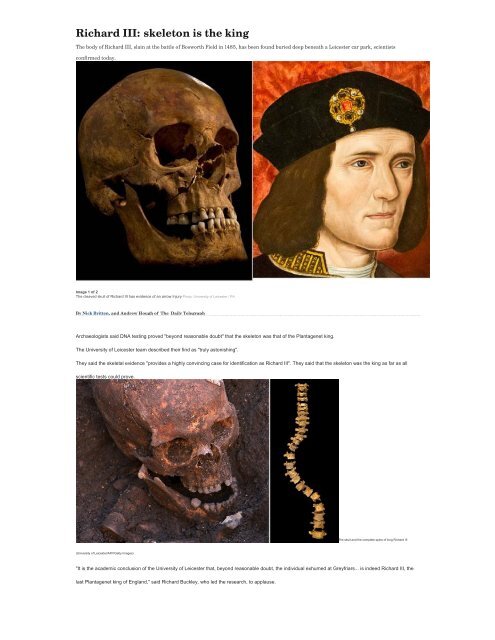Richard III: skeleton is the king - Gainsborough Old Hall
Richard III: skeleton is the king - Gainsborough Old Hall
Richard III: skeleton is the king - Gainsborough Old Hall
You also want an ePaper? Increase the reach of your titles
YUMPU automatically turns print PDFs into web optimized ePapers that Google loves.
<strong>Richard</strong> <strong>III</strong>: <strong>skeleton</strong> <strong>is</strong> <strong>the</strong> <strong>king</strong><br />
The body of <strong>Richard</strong> <strong>III</strong>, slain at <strong>the</strong> battle of Bosworth Field in 1485, has been found buried deep beneath a Leicester car park, scient<strong>is</strong>ts<br />
confirmed today.<br />
Image 1 of 2<br />
The cleaved skull of <strong>Richard</strong> <strong>III</strong> has evidence of an arrow Injury Photo: University of Leicester / PA<br />
By Nick Britten, and Andrew Hough of The Daily Telegraph<br />
Archaeolog<strong>is</strong>ts said DNA testing proved "beyond reasonable doubt" that <strong>the</strong> <strong>skeleton</strong> was that of <strong>the</strong> Plantagenet <strong>king</strong>.<br />
The University of Leicester team described <strong>the</strong>ir find as "truly aston<strong>is</strong>hing".<br />
They said <strong>the</strong> skeletal evidence "provides a highly convincing case for identification as <strong>Richard</strong> <strong>III</strong>". They said that <strong>the</strong> <strong>skeleton</strong> was <strong>the</strong> <strong>king</strong> as far as all<br />
scientific tests could prove.<br />
(University of Leicester/AFP/Getty Images)<br />
The skull and <strong>the</strong> complete spine of <strong>king</strong> <strong>Richard</strong> <strong>III</strong><br />
"It <strong>is</strong> <strong>the</strong> academic conclusion of <strong>the</strong> University of Leicester that, beyond reasonable doubt, <strong>the</strong> individual exhumed at Greyfriars... <strong>is</strong> indeed <strong>Richard</strong> <strong>III</strong>, <strong>the</strong><br />
last Plantagenet <strong>king</strong> of England," said <strong>Richard</strong> Buckley, who led <strong>the</strong> research, to applause.
<strong>Richard</strong> Taylor, <strong>the</strong> university's deputy reg<strong>is</strong>trar, said: "Today we bear witness to h<strong>is</strong>tory."<br />
a knife or dagger (University of Leicester/AFP/Getty Images)<br />
The lower jaw of <strong>king</strong> <strong>Richard</strong> <strong>III</strong> with a cut mark caused by<br />
It came 24 hours after an image of <strong>the</strong> battle-scarred skull of <strong>Richard</strong> <strong>III</strong> was released for <strong>the</strong> first time. Scient<strong>is</strong>ts also uncovered <strong>the</strong> grave site.<br />
The way <strong>the</strong>y found <strong>the</strong> <strong>skeleton</strong> suggested <strong>the</strong> <strong>king</strong> had been tied when he was buried. There has been extensive damage to <strong>the</strong> bones, scient<strong>is</strong>ts say.
The <strong>skeleton</strong> had an "unusually slender, almost feminine build for a man" and was aged between <strong>the</strong> late 20s and early 30s. <strong>Richard</strong> died aged 32.<br />
Without any "spinal abnormality", <strong>the</strong> <strong>skeleton</strong> would have been 5’ 8” high, which was above average height for a medieval man, scient<strong>is</strong>ts say.<br />
A total of 10 wounds have been d<strong>is</strong>covered made to <strong>the</strong> <strong>skeleton</strong>, including eight on <strong>the</strong> skull. The injuries suggest <strong>the</strong> <strong>king</strong> may have lost h<strong>is</strong> helmet during<br />
<strong>the</strong> battle which saw him deposed by Henry VII.<br />
a Leicester car park (University of Leicester / Rex Features)<br />
The remains of King <strong>Richard</strong> <strong>III</strong> found buried deep beneath<br />
The <strong>skeleton</strong> was uncovered last autumn amid <strong>the</strong> h<strong>is</strong>toric foundations of a Franc<strong>is</strong>can Friary in Leicester, beneath a council car park which <strong>is</strong> overlooked by<br />
Leicester Ca<strong>the</strong>dral.<br />
They will be reinterred early next year at <strong>the</strong> ca<strong>the</strong>dral, with a v<strong>is</strong>itor centre to be created nearby, which will tell <strong>the</strong> <strong>king</strong>'s story.<br />
A depiction of <strong>Richard</strong> <strong>III</strong> – on <strong>the</strong> white horse – at <strong>the</strong> Battle of Bosworth Credit: ALAMY<br />
Teams of experts carried out radio carbon dating, DNA tests and CAT scans and compared notes with experts in weapons and trauma, lifestyle and diet<br />
before announcing <strong>the</strong>ir findings today.<br />
They have d<strong>is</strong>closed that <strong>the</strong> skull appears to have suffered a severe blow.<br />
The body was identified just weeks into a project which began when experts identified <strong>the</strong> car park as <strong>the</strong> most likely h<strong>is</strong>torical location of <strong>the</strong> church of Grey<br />
Friars, where <strong>the</strong> King was said to have been buried after h<strong>is</strong> defeat in <strong>the</strong> Battle of Bosworth in 1485.<br />
The archaeolog<strong>is</strong>ts initially described <strong>the</strong> dig as a "long shot" but uncovered <strong>the</strong> foundations of a church along with two bodies, one of which would prove to<br />
be <strong>the</strong> King.
As Henry VII's troops dragged <strong>the</strong> corpse into Leicester its head <strong>is</strong> said to have struck a stone and broken open.<br />
The remains were dug up last September and Leicester University said <strong>the</strong>re was “strong evidence” that it was <strong>Richard</strong> <strong>III</strong>.<br />
<strong>the</strong> lost grave of King <strong>Richard</strong> <strong>III</strong> have d<strong>is</strong>covered human remains (PA)<br />
Archaeolog<strong>is</strong>ts searching under <strong>the</strong> city centre car park for<br />
The <strong>skeleton</strong> <strong>is</strong> not believed to have been buried in ei<strong>the</strong>r a shroud or a coffin, which although unusual for <strong>the</strong> time, tallies with h<strong>is</strong>torical accounts that<br />
suggest he was "irreverently buried" by Henry's forces.
<strong>Richard</strong> <strong>III</strong>, depicted by William Shakespeare as a tyrant who murdered two princes in <strong>the</strong> Tower of London, was killed at <strong>the</strong> Battle of Bosworth, bringing to<br />
an end <strong>the</strong> two-year dynastic struggle known as <strong>the</strong> War of <strong>the</strong> Roses and triggering <strong>the</strong> reign of <strong>the</strong> House of Tudor.<br />
It has been claimed <strong>the</strong> d<strong>is</strong>covery of <strong>Richard</strong>'s body will lead to a re-examination of h<strong>is</strong> reign and may go some way to rebalancing <strong>the</strong> largely negative<br />
portrayal offered by Shakespeare.<br />
http://www.telegraph.co.uk/technology/picture‐galleries/9822001/In‐pictures‐Nasas‐rover‐<br />
Opportunitys‐9‐years‐on‐<strong>the</strong>‐surface‐of‐Mars.html



